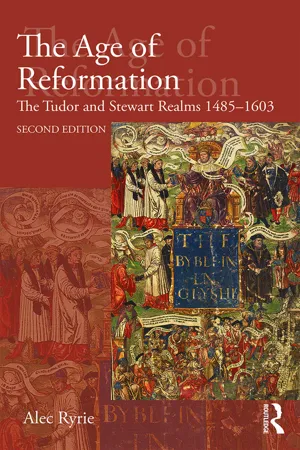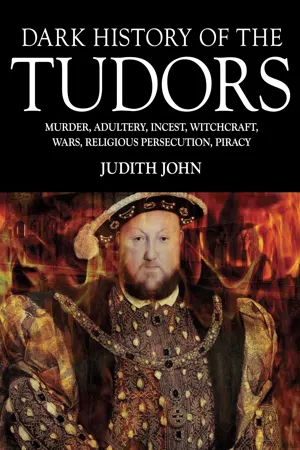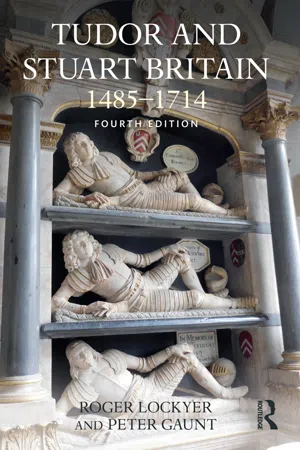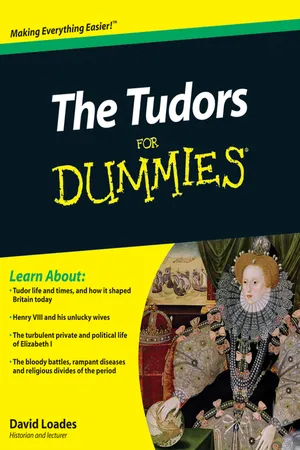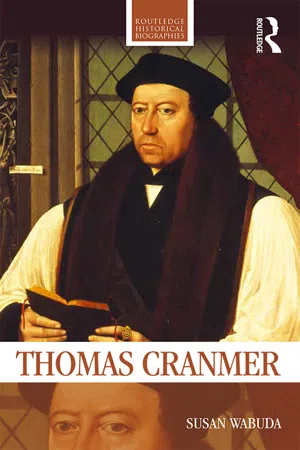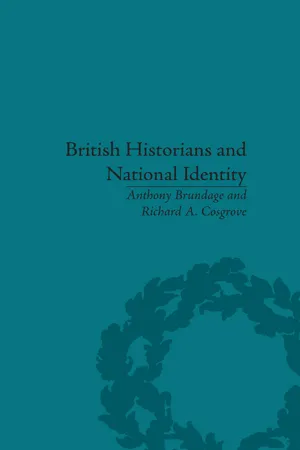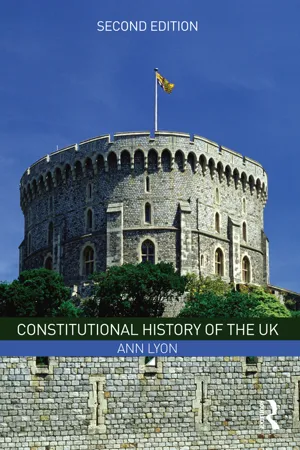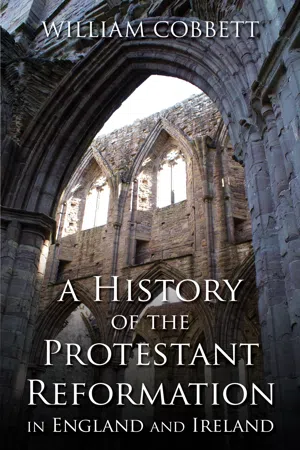History
Edward VI of England
Edward VI of England was the son of Henry VIII and became king at the age of nine after his father's death. His reign was marked by the influence of Protestant advisors and the establishment of Protestantism as the official religion of England. Edward's short reign was characterized by religious turmoil and attempts to consolidate Protestant reforms in the English church.
Written by Perlego with AI-assistance
Related key terms
10 Key excerpts on "Edward VI of England"
- eBook - ePub
The Age of Reformation
The Tudor and Stewart Realms 1485-1603
- Alec Ryrie(Author)
- 2017(Publication Date)
- Routledge(Publisher)
The English RevolutionEdward VI, 1547–53
The short reign of King Edward VI (1547–53) is easily overlooked. It has been treated either as a disreputably un-English interlude, or as a period of chaotic near-collapse, best hurried through en route to the sunlit uplands of Elizabeth I’s reign. Yet the reign was one of the most dramatic episodes in English history, when a series of profound changes were thrust on an unsuspecting country. It is the hinge on which the sixteenth century turned – for the whole of the British Isles, not merely for England. It was at least as momentous as the better-known ‘English Revolution’ of the mid-seventeenth century. Like all revolutions, this one failed. Like all revolutions, it changed everything that happened afterwards.Carnival: Protector Somerset’s ReformationFrom Henry VIII to Protector Somerset
The succession crisis that had dominated the middle of Henry VIII’s reign finally abated in 1537, when his third wife Jane Seymour at last bore him a son (at the cost of her own life). Young Prince Edward was born not a moment too soon, for his father’s health was already deteriorating. Henry suffered a bad fall from his horse in 1536, and thereafter, with his ability to exercise curtailed, his weight ballooned. Contrary to popular belief, he probably did not have syphilis, but he was troubled by a recurring ulcer on his leg and also by impotence (it seems that none of his last three marriages was consummated). By the mid-1540s, although only in his fifties, he was decaying into a raddled, bloated parody of his former self. As his health failed, a new succession crisis emerged: the prospect of a child king.Was England still an elective monarchy (p. 34)? If so, would it choose a child? The last boy king, Edward V, had lasted less than a month. It was easy to imagine another usurpation. A claim could have come from England’s most powerful nobleman, the duke of Norfolk; or, more likely, from his eloquent, headstrong son, the earl of Surrey. In 1543 a servant of one of Surrey’s friends declared that ‘if aught other than good should become of the king, he [Surrey] is like to be king’. Such talk was explosive. One of Surrey’s friends fell out with him in 1546, declaring that he would rather murder Surrey himself than see a boy king in his or his father’s custody. Soon thereafter, Surrey had a new coat of arms made for himself, which emphasised his own royal blood. In the febrile atmosphere of late 1546, this was folly. In December, Surrey and his father were suddenly thrown in prison and declared guilty of treason. The young earl was beheaded; his elderly father was due to follow him soon after. It was Henry VIII’s last judicial murder.1 - eBook - ePub
Dark History of the Tudors
Murder, adultery, incest, witchcraft, wars, religious persecution, piracy
- Judith John(Author)
- 2014(Publication Date)
- Amber Books Ltd(Publisher)
Edward VI as painted by Hans Holbein the Younger, circa 1538. The portrait shows the young Edward to be a happy and healthy child. The Latin text at the bottom of the picture encourages Edward to live up to his illustrious father’s example.IV
TUDORS
EDWARD VI: REFORMS, REBELLIONS AND ROUGES
King for barely six years, Edward VI did not even reach his majority before he died at the age of 15. The unknown Tudor, Edward was overshadowed by his larger-than-life father, Henry VIII, and his successors Mary I and Elizabeth I. Despite Henry VIII’s attempts to secure the throne for his only male heir, Edward VI would face threats to his crown and a reign filled with controversy and unrest.‘Edward VI lived only a few years... but he lived them worthily.’T he ‘godly imp’ was led by strong-willed men who became seduced by the thought of absolute power, yet Edward’s rule nevertheless cemented Protestantism as the new English faith, taking religious reforms further than his father ever intended. However, his ill-timed death left the Tudor monarchy in grave doubt as a succession battle was soon to erupt.Edward’s Childhood
Often described as a happy and lovable child, Edward spent his early childhood among women, who saw to the every want and need of the little prince. Beloved and treated as precious by his father (who, as a young boy, had resented the smothering upbringing of Henry VII and Margaret Beaufort), Edward was indulged and cosseted as the son and heir to the King of England, suffering none of the chaos that affected the childhood of both his sisters.Crowds have gathered en masse to cheer the coronation procession of the boy king. Edward was crowned on 20 February 1547 at Westminster Abbey, followed by a banquet at Westminster Hall. Six years later, Edward would return to the Abbey to be buried. - eBook - ePub
Tudor and Stuart Britain
1485-1714
- Roger Lockyer, Peter Gaunt(Authors)
- 2018(Publication Date)
- Routledge(Publisher)
Edward VI and Mary IThe mid-Tudor period in perspective
Falling between the two longest English reigns of the Tudor and Stuart age – those of Henry VIII and his younger daughter, Elizabeth – are the short and often troubled reigns of his son and his elder daughter. The status of the monarchs themselves created immediate problems, as one was male but a child and the other was an adult but a woman. Both situations gave rise to difficulties. Although Edward VI held opinions of his own, which increasingly had to be taken into account towards the end of his reign, by which time he was in his mid-teens, his smooth succession at the age of just nine and his early death, still a few months short of his sixteenth birthday, meant that throughout his reign real power and leadership were exercised by others acting in his name. Royal minorities often gave rise to factional infighting, power struggles, fluctuating policies and general uncertainty and to some extent all these features can be seen during Edward’s six-year reign. The occupation of the throne by a queen regnant was almost unprecedented in English history – while there had been queens of the Anglo-Saxon kingdom of Mercia who ruled alone and in their own hereditary right, the only previous attempt to pass the English crown to a woman, to Henry I’s daughter Matilda in the twelfth century, had almost immediately created bitter dispute, led to counterclaims by a male cousin and provoked civil war and Matilda was never crowned and in practice failed to establish her claim. In fact, Mary I fared much better, not least because in 1553 there was no plausible male claimant to the throne after her much younger half-brother’s death, and – active, determined and in her mid-thirties – she quickly overcame limited resistance mounted in the name of a rival female claimant and established herself securely as queen regnant. But her gender continued to be an issue during her five-year reign, seen especially in reaction to her quest for a husband and her subsequent marriage to a man who was both a foreigner and heir to or ruler of European territories. - eBook - ePub
- David Loades, Mei Trow(Authors)
- 2010(Publication Date)
- For Dummies(Publisher)
Part III Remembering the Forgotten Tudors: Edward VI and MaryIn this part . . .Okay, so everybody’s heard of Henry VIII and his daughter Elizabeth, but he had two other children and they ruled England too. Father’s many marriages caused chaos – not just a break with the pope and 1,400 years of history, but also a lot of confusion over who should sit on the throne after Henry.Edward should’ve been king, and he was, but the poor boy was a sickly child and died at 15. He was replaced by his big sister, Mary, and when she died at 42 the last of the Tudors, Elizabeth, got the top job.But it was hardly happy families. Henry had been a Catholic who’d quarrelled with the pope. Edward was brought up a Protestant (they hated the pope). Mary was a Catholic (but she didn’t like the pope either!). So for 11 impossible years, the religion of England was like a yo-yo. And if you were on your way down when everyone else was going up, there was a chance you’d be burned alive at Smithfield in London.Passage contains an image
Chapter 7 Ruling from the Nursery: Edward VI and His Protectors In This Chapter Carrying out Henry VIII’s will Protecting the boy king Sorting the Scots, fighting the French and dealing with English revolts Changing protectorsWSetting Up a Protectoratehen Henry VIII died in January 1547, growing unrest in England and Scotland meant the country needed a strong leader. But Henry’s successor, his son Edward – born at Hampton Court on 12 October 1537 – was only a boy. So the new king would need a regent in place to act as his protector, particularly in maintaining the Royal Supremacy his father had instigated (see Chapter 6). As we outline in this chapter, the young king’s uncle, Edward Seymour, was first in line for the job of lord protector; and hot on his heels was John Dudley, earl of Warwick.Princes were allowed to rule by themselves from the age of 18, but Edward was only 9. Queen Catherine (Parr) was sidelined, and the executors of Henry’s will, who shared the former king’s views on Church and state, worked to quickly establish a protectorate to act for the boy king. - eBook - ePub
Rebellion and Riot
Popular Disorder in England During the Reign of Edward VI
- John A. Andrew, III(Authors)
- 2000(Publication Date)
- The Kent State University Press(Publisher)
And the first degree is to look backward, whether at your first setting forward, you took not a wrong way as (saving your favor) I think you did; for you have cared to content all men (which is impossible and specially being subjects in such a subjection as they were left) and be loth or rather afraid to offend any. Extremities be never good, and for my part I have always hated them naturally too much in our old majesty’s time (I speak with reverence and in the loyalty of a true heart to my sovereign lord that was and that now is) and too much in our majesty’s time that now is.… Then all things were too straight and now they are too loose; then was it dangerous to do or speak though the meaning were not evil; and now every man hath liberty to do and speak at liberty without danger.Sir William Paget to Protector Somerset, Christmas Day, 15482. THE ENGLAND OF EDWARD VIIn 1547 Englishmen of all ranks and degrees mourned the death of Henry VIII, a titan among kings who successfully defied the Pope and wrested Boulogne from the French. Henry, for all of his failings, remained popular among the great majority of his subjects. The king’s robust zest for life counted for more among the commons than his failure to live up to the expectations of his early admirers. Now that the old man was gone, attention inevitably focused on his nine-year-old-son, Edward VI.Everyone rejoiced at the young king’s festive coronation, for not many could remember his father’s accession in 1509. At the same time there was apprehension, because it was plain to all that a small boy could not govern the country. Before the establishment of the Tudor dynasty, factionalism, court intrigue, and even civil war had accompanied minority rule, but that was part of the distant past. King Edward was said to be a young Josiah, a just and powerful lawgiver under whom the country would rise to new heights of greatness. The aristocracy may have doubted whether the frail and studious child would ever equal much less exceed his father’s renown. The king’s potential for leadership, however, was not the major concern of the vast majority of the population whose world centered on the village or hamlet. Among the commons few had any reason to expect that life under Edward VI would be better than in the past, but all must have prayed to God that it would not be worse. - eBook - ePub
- Susan Wabuda(Author)
- 2017(Publication Date)
- Routledge(Publisher)
Book of Common Prayer, 1547–1552‘Stir up we beseech thee, O Lord, the wills of thy faithful people, that they plenteously bringing forth the fruit of good works: may of thee, be plenteously rewarded: through Jesus Christ our Lord.’1The purge
The opening salvos of Edward VI’s reformation were fired not at his coronation, but in sermons that were delivered in the days that followed it. On Ash Wednesday, 23 February 1547, Nicholas Ridley denounced as papistical the use of holy water and the images of saints when he preached before the king at court. His themes were taken up again on the following Sunday at Paul’s Cross. The first important sermons that were delivered in the young king’s reign indicated that further reforms would be encouraged now.2The Lord Protector Somerset had already assured Gardiner that there would be no substantial alterations in religion until the king reached full age. Disquieted by Ridley’s sermon, and chafing from his exclusion from the council of executors, Gardiner wrote Somerset to warn him that no changes should take place in the realm, not in its religion, laws, lands, or decrees, until Edward reached his majority.3 But Gardiner was on the wrong side of the decisions that were being made at the beginning of the reign.On Sunday 6 March 1547, Thomas Wriothesley was overthrown as lord chancellor, and the Great Seal was taken away from him.4 His demotion was a successful coup mounted by the evangelicals in the new king’s government. The council of executors that Henry VIII had established in his will to rule England during the minority of his son lasted only six weeks. Now Somerset emerged as the initial strong man of Edward’s government, with more powers than the dead king had wanted any single person to enjoy.The last occasion in Edward’s reign when all London parishes were asked to celebrate requiem Masses was in June 1547 to mark the death of the king of France. Francis I had died at the end of March, only two months after Henry. Although their reigns had been marked by the bitter wars they waged against each other, stories were told that the French king was never happy again once he learned of Henry’s death. The international perspective worsened dramatically. On 24 April, at the Battle of Műhlberg, the Emperor Charles V won a decisive victory against the League of Schmalkalden. Duke John Frederick of Saxony was wounded and taken prisoner. Briefly condemned to death, he capitulated and surrendered his government into the hands of a cousin. Landgrave Philip of Hesse was held captive until 1552. Charles imposed a series of restrictions in Lutheran regions, known as the Interim, which threatened the cradle of Protestantism. - eBook - ePub
- John Lawson(Author)
- 2013(Publication Date)
- Routledge(Publisher)
Connected with the demand for reformation, but in ways not easy to define, was the Renaissance—the refructifying of art, literature and learning through the stimulus of the rediscovery of classical antiquity, which marks the later fifteenth and sixteenth centuries. Educationally, the Renaissance expressed itself in humanism, which meant a new interest in man and human perfectibility, the rejection of scholasticism, a passion for pure Latinity and the study of Greek; and with this went an increasing output of relatively cheap books of all kinds made possible by the invention of printing. Most influential of the northern humanists was the Dutchman Erasmus (d. 1536), who visited England several times and taught for two years at Cambridge. A prolific writer of schoolbooks, he was the principal means of introducing the cultivation of pure classical Latin into the schools. Although always a Catholic himself, he satirized with wit and elegance clergy, monks, friars, bishops and popes, the crabbed syllogisms of the schoolmen, the obscurantism and materialism of contemporary religion; and the newly literate, urban middle classes provided ready readers for his books, which the printing presses poured out. Among some scholars, including a small group at Cambridge in the 1520s, his Latin version of the New Testament helped to sow the intellectual seeds of Reformation.State religion and the Church of England
In England the Reformation began with Henry VIII’s desire for a divorce, and it took shape with his determination to sever the legal ties with Rome when Wolsey failed to obtain him a divorce from the Pope. The first stage, from 1529 to 1534, was predominantly political; it ended with the rejection of papal jurisdiction and the substitution of the royal supremacy over the Church in England: a revolution made easy by popular anti-papal feeling and the spread of reformist ideas from Luther’s Germany. This was followed, for financial rather than religious reasons, by the dissolution of the monasteries, beginning with the smaller ones in 1536 and culminating in total suppression in 1539-40. This was a stupendous act of nationalization, and the disposal of monastic lands in the greatest property sale in our history was followed by the rise of the gentry to power as the English ruling class. More omnipresent and familiar than the monasteries, however, were the colleges of priests, chantries and gilds, and their dissolution and expropriation by Edward VI in 1548 was, so far as ordinary people were concerned, an even more decisive breach with the Catholic past. The final stage was the reformation of doctrine; deeply influenced by Calvinism, this started under Edward VI and, after the brief Catholic reaction of Mary’s reign, was accomplished in the early years of Elizabeth’s. The Church of England that emerged preserved intact its ancient episcopal organization and legal structure, but had a new liturgy embracing Catholic and Protestant elements, set out in English in the Prayer Book; and a broad compromise theology summarized in the Thirty-nine articles. In 1559 the Queen was made its ‘Supreme Governor’ by the Supremacy Act; and by the Uniformity Act of the same year all her subjects were obliged under penalty to accept its form of worship and none other. During the greater part of Elizabeth’s reign the overriding concern of the central government was to strengthen this new religious establishment, and protect it from dissentient minorities—Catholics on the one hand, and, to a less extent, radical Calvinist nonconformists on the other.57 - eBook - ePub
British Historians and National Identity
From Hume to Churchill
- Anthony Leon Brundage(Author)
- 2015(Publication Date)
- Routledge(Publisher)
24 As he pondered the overall scheme and began his research, the structure began to shift. It no longer seemed optimal to start in 1509 and conclude nearly a century later in 1603. Instead the two critical dates of 1529 and 1588, entailing a total of less than sixty years, were to mark the boundaries of the history. The span of years to be covered was to be cut almost in half, while the total length was to be doubled, to twelve volumes rather than six, half of them to that part of the Elizabethan era he had chosen. The fall of Cardinal Wolsey and the consequent breaking free from Rome thus became the shaping framework for the early volumes, while 1588 allowed the first thirty years of Elizabeth’s long tenure to be treated as the unfolding of English greatness in the wider world and its defiance and humbling of the greatest power of the age, Catholic Spain. The English Reformation, treated as a good deal more than the manoeuvrings of king and Parliament, was to be given pride of place as the great defining and shaping force of national character.In adopting this narrative and interpretive framework, Froude was flying in the face of long-held views about the sixteenth century in general and about Henry VIII in particular. For the large numbers who held Whig, constitutionalist views, it was difficult not to regard the whole era as one of ‘Tudor despotism’. This seemed especially true of the reign of Henry VIII, a monarch considered by many to have been driven by his own desires, subjecting the realm to his personal quest for power and gratification, little better than a crowned ruffian. Edward was given something of a pass by constitutionalists, because of his tender years, advanced Protestant views, and the problems of faction and the overweening ambitions of dominant grandees. Mary was in a special category, of course, because of her Spanish marriage and supposed savagery in trying to force England’s return to the Catholic faith. Elizabeth was the Victorians’ favourite Tudor, largely for her courage and determination in facing down the Spanish threat, and for some, her perceived adherence to a via media in religion. Even those prone to accord her favourable treatment, however, were not likely to give her high marks in constitutional terms. Whatever progress was seen in the advance of representative government was apt to be credited to parliamentary initiatives. Thus Froude’s work was cut out for him. - eBook - ePub
- Ann Lyon(Author)
- 2016(Publication Date)
- Routledge(Publisher)
5 The Reign of Edward IOverview
- Comparison with Henry II
- Reassertion of royal authority in early years of reign
- Administrative and legal changes
- Development of parliament during the reign
- Conquest of Wales and its aftermath
- Edward I and Scotland
- Crisis of the reign 1297–1303
5.1 Man and king
Edward I may be bracketed with his great-grandfather, Henry II, as the greatest of England’s medieval kings. There are more than passing similarities. Both restored firm royal authority after periods of chaos, presided over major developments in the law and ended their reigns in failure and disappointment. For Henry this came through rebellion by his sons, in Edward’s by his overstretching the resources of his kingdom and his subjects’ goodwill in wars in France and Scotland. Henry died before there was serious discord at home, but Edward was faced 25 years into his reign with a major political crisis, which might well have threatened the security of a less awe-inspiring monarch.In Edward’s reign Wales was conquered, and largely absorbed into the English system of royal government. Scotland might have gone the same way, were it not for the determination of a few among the Scots to maintain their ancient independence. Considerable developments took place in law and the administration of justice. Edward’s financial insecurity in the last years of his reign led to concessions which mark a further step in the slow evolution of representative government.Aged 33 at the time of his accession, 35 when he began his personal rule, Edward I was quite unlike the Anglo-Saxon king whose name he bore. He served a long apprenticeship for kingship, spending a period of relative autonomy as ruler of Gascony, and gaining stature on the national and international stages during the Barons’ War and a crusade. His crusading achieved very little – his allies never reached the Holy Land, and his own force was too small to campaign on any significant scale – but Edward nevertheless returned home in 1274 a hero. Many took the cross, but few fulfilled their crusading vows; Edward’s fame was heightened by his surviving a serious assassination attempt with a poisoned dagger. - William Cobbett(Author)
- 1988(Publication Date)
- TAN Books(Publisher)
193. In pursuance of this plan, and in conformity with my promise to conclude my little work in ten chapters, I shall distribute my matter thus:—in chapter VII. (the present) the deeds and events of the reign of Edward VI. In chapter VIII., those of the reign of Queen Mary. In chapter IX., those of the reign of Queen Elizabeth; and in chapter X., the facts and arguments to establish my main point, namely, that the thing impudently called the "Reformation" impoverished and degraded the main body of the people. In the course of the first three of these chapters I shall not touch, except incidentally, upon the impoverishing and degrading effects of the change, but shall reserve these for the last chapters, when, having witnessed the horrid means, we will take an undivided view of the consequences, tracing those consequences down to the present day.194. One of Henry's last acts was a will by which he made his infant son his immediate successor, with remainder, in case he died without issue, to his daughter Mary first, and then in default of issue again, to his daughter Elizabeth, though, observe, both the daughters had been declared illegitimate by Act of Parliament, and though the latter was born of Anne Boleyn while the king's first wife, the mother of Mary, was alive. Parliament had given the king the right to determine the succession by will.195. To carry this will into execution, and to govern the kingdom until Edward, who was then ten years of age, should be eighteen years of age, there were sixteen executors appointed, amongst whom was Seymour, Earl of Hertford, and the "honest Cranmer."1 These sixteen worthies began by taking, in the most solemn manner, an oath to stand to and maintain the last will of their master. Their second act was to break that oath by making Hertford, who was a brother of Jane Seymour, the King's mother, "protector," though the will gave equal powers to all the executors.2 Their next step was to give new peerages to some of themselves. The fourth, to award to the new peers grants of the public money. The fifth was to lay aside at the coronation the ancient English custom of asking the people if they were willing to have and obey the King. The sixth was "to attend at a solemn high mass."3
Index pages curate the most relevant extracts from our library of academic textbooks. They’ve been created using an in-house natural language model (NLM), each adding context and meaning to key research topics.
